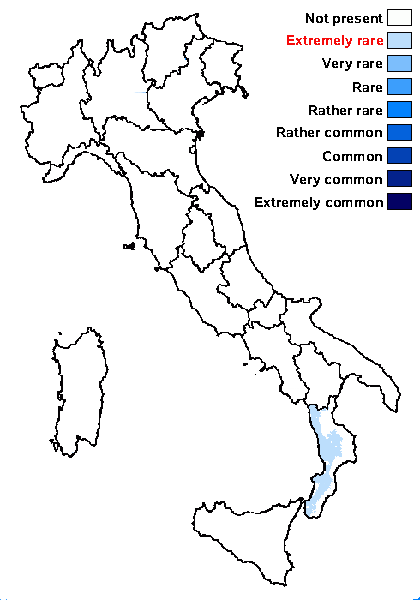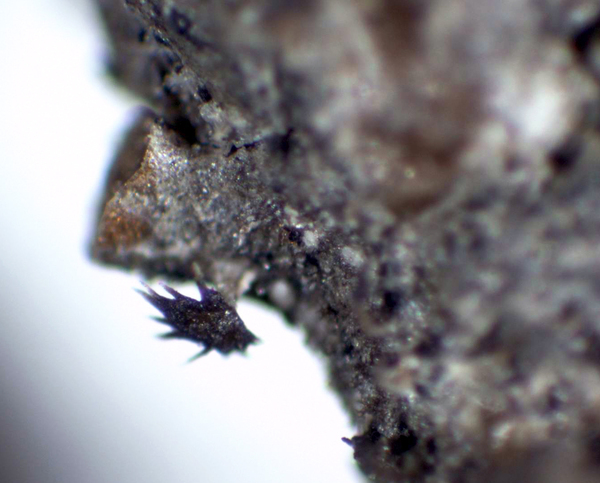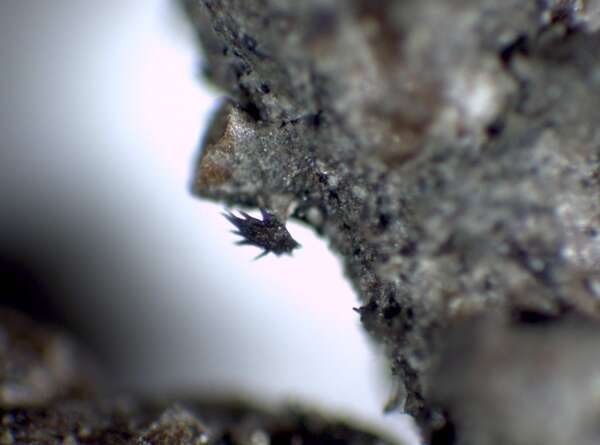Gyalideopsis piceicola (Nyl.) Vězda & Poelt
Nova Hedwigia, 53: 112, 1991. Basionym: Lecidea piceicola Nyl. - Flora, 69: 99, 1886.
Synonyms: Gyalideopsis alnicola W.J. Noble & Vězda
Distribution: S - Cal (Puntillo 1996).
Description: Thallus crustose, thinly episubstratic, smooth, whitish grey to greenish grey, ecorticate, not sharply delimited, without a distinct prothallus. Hyphophores rare, scale-like or shortly stalked, erect, fan-shaped, whitish to dark brown, 0.3-0.35 mm high and up to 0.15-0.25 mm wide in upper part. Apothecia usually frequent, scattered, round or irregularly wavy in outline, 0.1-0.3(-0.5) mm across, 0.2-0.3 mm high, sessile and strongly constricted at base, with an initially urceolate, then slightly concave, dark red-brown disc, and a raised, entire or radially split, black, finally often thin and almost excluded proper margin. Proper exciple 70-80 µm wide laterally, red-brown in outer part, colourless within, of loosely anastomosing hyphae embedded in a gelatinous matrix; epithecium olive-brown, c. 20 µm high; hymenium colourless, 60-80 µm high; paraphyses c. 1 µm thick, simple or richly branched and anastomosing in upper part; hypothecium colourless, c. 10 µm high. Asci (2-)4-6(-8)-spored, cylindrical-clavate, thin-walled, apically thickened, the wall I-, the contents K/I+ reddish. Ascospores with 5 transverse septa and (0-)1 longitudinal septum, hyaline, ellipsoid to fusiform, straight or slightly curved, (12-)15-20 x 4.5-6(-7) µm. Photobiont chlorococcoid. Spot tests: thallus K-, C-, KC-, P-, UV-. Chemistry: without lichen substances.Note: this species has been previously reported from Calabria as G. alnicola, collected on twigs of Abies in a damp forest. However, according to Tønsberg, this species is a juvenile G. piceicola with whitish hyphophores, based on his observations in the Pacific Northwest of North America (from where G. alnicola was described): well-developed specimens often occur together with a mixture of young and white and mature and brown hyphophores. It is included in the Italian red list of epiphytic lichens as “Critically Endangered” (Nascimbene & al. 2013c).
Growth form: Crustose
Substrata: bark
Photobiont: green algae other than Trentepohlia
Reproductive strategy: mainly sexual
Commonnes-rarity: (info)
Alpine belt: absent
Subalpine belt: absent
Oromediterranean belt: absent
Montane belt: extremely rare
Submediterranean belt: absent
Padanian area: absent
Humid submediterranean belt: extremely rare
Humid mediterranean belt: absent
Dry mediterranean belt: absent

Predictive model
Herbarium samples
Growth form: Crustose
Substrata: bark
Photobiont: green algae other than Trentepohlia
Reproductive strategy: mainly sexual
Commonnes-rarity: (info)
Alpine belt: absent
Subalpine belt: absent
Oromediterranean belt: absent
Montane belt: extremely rare
Submediterranean belt: absent
Padanian area: absent
Humid submediterranean belt: extremely rare
Humid mediterranean belt: absent
Dry mediterranean belt: absent

Predictive model
| Herbarium samples |
 Index Fungorum
Index Fungorum
 GBIF
GBIF





